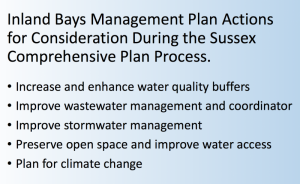Scientists: Sussex needs more environmental protections

Environmentalists familiar with Sussex County's current comprehensive plan say county officials have yet to follow through on promises made in 2008 to protect coastal resources and residents.
In a forum hosted by the League of Women Voters of Sussex County April 26, three environmental scientists discussed environmental portions of Sussex County's comprehensive plan to show the public what the county said it would do in its 2008 plan, what officials have followed through on, and what still must be done in the new plan to protect natural resources.
Retired environmental scientist and land-use planner Carol Bason said as officials worked on the 2008 plan, citizens and experts from the Delaware Center for the Inland Bays, where she volunteered at the time, recommended ordinances and regulations, including effective buffers on tidal and nontidal waterways, protecting open space, and adopting a transfer of development rights program to accommodate growth while protecting vulnerable environmental areas.
“We weren't against growth, but we were against sprawl and growth that didn't protect the environment that we live in,” she said.
The county agreed it would consider the center's recommendations, Bason said, but four environmental ordinances that followed are voluntary and mostly nonbinding.
“The commitment was light. But it's more than we had before,” she said. “We don't have anything that actually specifies how these things need to be protected. We need binding design standards, not voluntary ones.”
Bason pointed to the county's environmentally sensitive development district overlay zone, a land-use category included in the 2008 comprehensive plan that covers a large portion of the Inland Bays watershed, mostly waterfront parcels. The district recognizes environmentally sensitive areas, but also allows for commercial and residential uses in those places.
“So, the county said in its comprehensive plan, this is a valid public purpose for open spaces to preserve these environmentally sensitive areas,” she said. At the same time, these areas were added to the county’s seven growth areas. “Which means it may be environmentally sensitive, but it is developing. It is the growth area. That may or may not make sense to you, so I'll leave it at that,” she said.
Center Executive Director Chris Bason said the health of the Inland Bays is improving, but the pace of development in eastern Sussex County presents challenges.
“A lot of this development, as Carol pointed out, is in the environmentally sensitive development area, and that is close to the water, where it can have a disproportionate impact on the water,” he said. “We know that habitat protection and wise management of stormwater and wastewater will be increasingly important for our bays.”
Bason said scientists have determined that a watershed with 10 percent impervious surface – hard coverage from driveways, roads or buildings – will experience water quality issues, such as nutrient pollution. The center's 2016 State of the Bays report found the Inland Bays watershed has crossed that 10 percent threshold.
The center again has provided the county with a list of recommendations for the 2018 comp plan, including increasing and enhancing buffers, improving wastewater and stormwater management, providing access to open space and planning for climate change.
When the county wrote the 2008 plan, climate change was not at the forefront, said Susan Love, climate and resiliency planner with the Delaware Department of Natural Resources and Environmental Control.
“It wasn't until 2008 that the state started planning for sea level rise,” Love said. “Now we have a tremendous amount of information that can be utilized for local planning.”
Love said with current projections showing up to 1.5 meters of sea level rise by the end of the century, it's important for local governments to consider sea level rise and climate change in long-term plans.
“That is going to have some very significant impacts here for your county,” she said. “Local actions are incredibly important. The decisions we make about where and how to treat our wastewater and where we get drinking water, where we place commercial and residential development, those decisions we make today are out 60, 100 years. If we build a bridge that's not high enough, in 10 to 20 years, we'll have to build it higher or remove it.”
“Don't let anybody tell you that people in this state don't want to do anything about climate change. That is bunk,” she said. “If you think about the kinds of changes climate change is going to bring to this county and to this state, it has impact on where you might want to use land, how and where you're going to build roads, what kind of economic development you can do.”
In addition to planning for climate change, establishing better waterway buffers, and developing a transfer of development rights or related program, Carol Bason said one of the most important things needed in the new comprehensive plan is public input.
“Once that draft is written, you need to be in those seats,” she said. “The county is looking for us. They will listen if we're there.”




























































